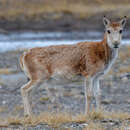Biology
provided by Arkive
Mating occurs in November and December (2), at this time males fight fiercely in an effort to control access to groups of 10 – 20 females (4). Females migrate north to give birth, over 300 km away, in June and July (2). A single calf is usually born, although life expectancy is extremely low in this harsh environment (2).
Tibetan antelope are extremely wary and alert; partially concealed, they rest in depressions dug into the soil, which provide protection from mountain winds and predation (4). Herds mainly browse in the morning and evening, resting at midday (4).
Conservation
provided by Arkive
Tibetan antelope are protected by law in China, India and Nepal (2), and international trade is prohibited by their listing on Appendix I of the Convention on International Trade in Endangered Species (3). Until 2002, shahtoosh shawls were legally produced in the states of Jammu and Kashmir in India but a vital ban on manufacture has now been introduced (7). Widespread education and anti-poaching campaigns have been carried out and these have gone some way towards slowing the decline in this magnificent species (2). There is evidence that illegal trade still continues however (7) and conservation efforts must continue.
Description
provided by Arkive
The Tibetan antelope, or 'chiru', is well known for possessing the finest and warmest wool in the animal kingdom. This adaptation provides warmth in the harsh climate of the Tibetan plateau but has contributed greatly to this species' decline (2). These antelope are most closely related to wild sheep and goats, they have grey to reddish-brown coats with a remarkably soft and dense undercoat (2). The underparts are creamy white in colour and the bulbous nostrils have small inflatable sacs on the side (4). Male Tibetan antelope have slender, black horns that may reach 60 centimetres in length; in winter they possess black markings on the face and legs (2).
Habitat
provided by Arkive
The Tibetan antelope inhabits harsh steppe areas at elevations of 3,700 to 5,500 metres above sea level (4), where temperatures can fall to -40°F (2).
Range
provided by Arkive
Endemic to the Tibetan Plateau, this antelope is found mainly in Chinese regions although some individuals migrate to Ladakh in India (2).
Status
provided by Arkive
Classified as Endangered (EN – A2d) on the IUCN Red List 2002 (1), and listed on Appendix I of CITES (3).
Threats
provided by Arkive
Large herds of antelope previously roamed the Tibetan plateau, and they are the only large mammals native to this region. In the 1990s however, a worrying decline in numbers was recorded and the population was estimated to have fallen to around 75,000 animals (5), with as many as 20,000 individuals killed annually (2). The principal cause of this decline is to supply the 'shahtoosh' trade; the production of shawls made from the fine, warm wool of this species. Shahtoosh stands for 'king of wools' in Persian and became a sought-after fabric in the fashion capitals of the world towards the end of the 20th Century (6). Up to five antelope are needed to produce a single shawl and these can fetch up to US$ 15,000 on world markets (2).

